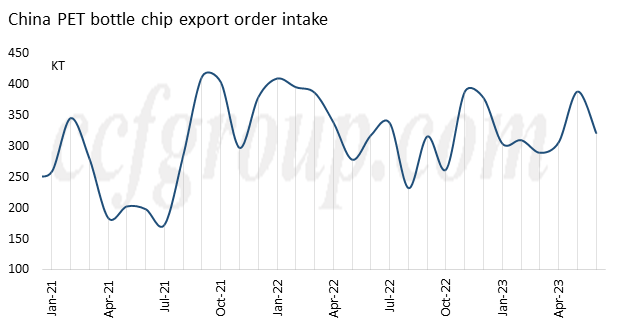PET bottle chip processing spread constantly low, industry performance really poor ?
Recently, PET bottle chip prices both in and abroad have rebounded, but the processing spread has been further compressed to less than 700yuan/mt. In some cases, the spot processing spread is only 500yuan/mt for some large order. What are the reasons behind this issue? Does it indicate a poor performance in the PET bottle chip industry?
Firstly, according to CCFGroup info, the overall inventory of PET bottle chip factories has not been high recently. Generally, it has been maintained at around 10-15 days for the past six months, which is within the normal range (hence this can also support plants to maintain high runs). Recently, with the increase in consumption of summer beverages and edible oils, factory delivery volume has gradually increased, and physical inventory has also dropped to slightly above 10 days.

But why has the market perceived an increase in PET bottle chip inventory? On one hand, there is a lot of market speculation and rumors, which, after multiple iterations, tend to represent the situation of individual factories as indicative of the entire industry. On the other hand, as PET bottle chip orders are often pre-sold, the industry traditionally focuses more on the delivery of PET bottle chip from the factories and the speed of pick-up by downstream end-users and traders, rather than the actual inventory levels of the factories themselves. In general, during the summer season, factory shipping volume is usually high, and they won't accumulate much inventory or rather gradually reduce their inventory levels. Recently, most market participants have noticed an upward trend in PET bottle chip inventory, while the willingness of PET bottle chip factories to hold prices firm remains strong. This is mainly due to the increase in inventory that is in circulation, as inventory pressure has shifted from the PET bottle chip factories to the downstream end-users or trading channels. However, the downstream demand has been mediocre due to relatively strong prices of upstream raw materials. Thus, even if the PET bottle chip factories wanted to hold prices firm, they have limited ability to do so, resulting in processing spread being suppressed at low levels.
Secondly, the export orders for PET bottle chip are not as "poor" as the rumors suggest, but rather transitioning from the previous years' frenzy to a more normal state. Compared to the same period last year, the performance of export orders this year may not be as surprising. However, in terms of the proportion of exports, the actual export orders for PET bottle chip factories are still within an acceptable range. Specifically, during the second quarter, export orders were 310,000 tons in April, 390,000 tons in May, and 320,000 tons in June, with an average monthly export order volume of around 340,000 tons, accounting for approximately 31% of the total production. This year, due to the gradual transition of Europe and the United States from hoarding goods to consumption of inventory starting from May and June, their demand for further replenishment has significantly declined. Previously, Chinese manufacturers could indirectly reach the end-users through alternative channels. However, due to the interruption of demand from this particular end-user segment, it is quite challenging for Chinese PET bottle chip companies to maintain export orders above 300,000 tons.

In addition, since June, downstream end-user enterprises have gradually ramped up their O/R. According to CCFGroup information, water enterprises are maintaining a running rate of 90-100%. Particularly, this year, the high temperatures in the northern regions started earlier, leading to increased demand in the northwest and northeast areas. As for PET sheet production, large-scale enterprises in East China have increased their O/R to around 70-80%, and to 50-70% in South China. In the edible oil industry, recent order performance has been satisfactory, and most oil factories are operating at full capacity. Therefore, recently, an increase in replenishment of PET can be observed from end-user enterprises to meet the additional summer demand.
![V7{NO~PD6]HI~FG%TM[`}5O.png V7{NO~PD6]HI~FG%TM[`}5O.png](https://pic.ccf.com.cn/2023/07/2023071103353952.png)
However, overall, the market sentiment for PET bottle chip remains conservative and cautious. The main reason is the addition of nearly 5 million tons of new capacity this year, which further weakens the supply-demand dynamics. With the expectation of significant amount of new capacity entering the market, it is unrealistic for PET bottle chip factories to sustain price increase. As seen from previous market trends, once prices rise, end-user factories tend to adopt a wait-and-see approach and only take action when prices drop to their desired levels, leading to most transactions occurring in the lower price range.
Therefore, considering that processing spread for PX downstream products are not high and some cash flows are continuously in a loss-making state, if the market develops in the future, there is a high probability of gradual upward price movement (unless factories sacrifice some processing spread to compete for market share). This would require several conditions to be met: firstly, an expansion of PTA unit maintenance due to loss-making processing spread; secondly, macroeconomic changes driving a resurgence in crude oil prices; and thirdly, an improvement in end-user confidence and an increase in replenishment willingness.
- Top keywords
- Cotton Price
- Cotton Futures Price
- Cotton Futures
- CZCE
- PTA Futures Price
- Chemical Fiber
- Polyester Prices
- Wool price
- PTA Futures
- Shengze Silk
- China
- Yarn Price
- price
- China Textile City
- Fibre Price
- Benzene Price
- Cotton
- Index
- Cotton Index
- PTA
- fabric price
- NYMEX
- Top 10
- textile industry
- Spot Cotton
- Cotton Yarn
- Polyester Price
- Futures
- PTA Price
- cotton yarn price

